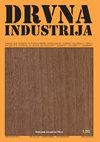硼、铜基木材防腐剂处理苏格兰松的燃烧和耐腐性能
IF 0.8
4区 农林科学
Q4 MATERIALS SCIENCE, PAPER & WOOD
引用次数: 0
摘要
几十年来,硼酸、硼砂或四水合二异戊硼酸盐形式的硼化合物一直被用作木材防腐剂行业的杀虫剂、杀菌剂和阻燃剂。此外,铜是大多数相对现代的防腐剂中最常用的成分,因为它对真菌非常有效。本研究的目的是研究我们小组开发的硼铜基溶液的燃烧和耐衰变性。这些溶液含有硼酸、十水硼酸钠、羟基碳酸铜、乙醇胺、季铵化合物(苯扎氯铵)和/或有机酸(辛酸)。根据ASTM D1413-07标准,采用自行研制的真空压力浸渍系统对樟子松木材进行防腐处理。根据EN 113标准测定对白腐真菌和褐腐真菌的耐腐烂性能,并根据ASTM E160-50标准进行燃烧试验。所有浸渍的木材样品都对白色(Trametes versicolor L.)和棕色(Coniophora puteana L.)真菌具有高度抗性。此外,在燃烧试验方面,它们给出了比对照样品更好的结果。本文章由计算机程序翻译,如有差异,请以英文原文为准。
Combustion and Decay Resistance Performance of Scots Pine Treated with Boron and Copper Based Wood Preservatives
Boron compounds in the form of boric acid, borax or disodiumoctaborate tetrahydrate have been used as insecticide, fungicide and fire retardant in wood preservatives industry for decades. Also, copper is the most commonly used component in most of relatively modern preservatives as it is highly effective against fungi. The objective of this study was to investigate the combustion and decay resistance of boron-copper based solutions which were developed by our group. These solutions contain boric acid, sodium borate decahydrate, copper hydroxy carbonate, ethanolamine, quaternary ammonium compound (benzalkonium chloride), and/or organic acid (octanoic acid). Scots Pine (Pinus sylvestris) woods were treated with the preservatives according to ASTM D1413-07 standard by vacuum-pressure impregnation system, which was developed by our group. Decay resistance performances against white and brown rot fungi were determined according to EN 113 standard and combustion tests were performed with respect to ASTM E160-50 standard. All the impregnated wood samples were found highly resistant to both white (Trametes versicolor L.) and brown (Coniophora puteana L.) fungi. Besides, they gave better results than the control samples in terms of combustion tests.
求助全文
通过发布文献求助,成功后即可免费获取论文全文。
去求助
来源期刊

Drvna Industrija
MATERIALS SCIENCE, PAPER & WOOD-
CiteScore
1.80
自引率
9.10%
发文量
32
审稿时长
>12 weeks
期刊介绍:
"Drvna industrija" ("Wood Industry") journal publishes original scientific and review papers, short notes, professional papers, conference papers, reports, professional information, bibliographical and survey articles and general notes relating to the forestry exploitation, biology, chemistry, physics and technology of wood, pulp and paper and wood components, including production, management and marketing aspects in the woodworking industry.
 求助内容:
求助内容: 应助结果提醒方式:
应助结果提醒方式:


